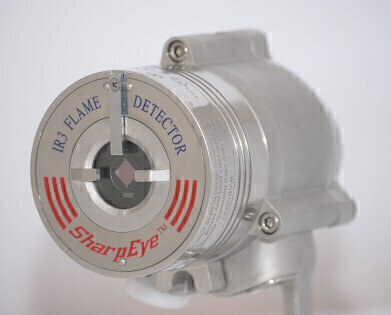Analytical Instrumentation
Bio-fuel Plants Protected by Explosion-proof Flame Detectors
Jan 06 2009
The unique fire and explosion hazards in the emerging alternative fuels industry have led Spectrex Inc., (USA), to develop specific models as part of its explosion-proof SharpEye 40/40 series Optical Flame Detectors to protect bio-fuels facilities.
The new SharpEye 40/40 series flame detectors provide the most comprehensive protection against hydrocarbon–based and water vapors combustion products types of fuel and gas fires, with several models that feature enhanced sensitivity to ethanol and other alcohol derivates that serve as bio-fuels.The 40/40 Series includes a comprehensive range of IR, UV, UV/IR, IR3 and Multi-spectral flame detectors that provide superior performance with high reliability and immunity to false activation.
The Bio-Fuels industry includes biodiesel (synthetic diesel) plants that produce diesel fuel from biomass, ethanol fuels produced from grains, cellulose and sugar cane, renewable diesel produced from thermo-depolymerized oils and fats, various hydrocarbons/biomass-to-liquid processes that produce alternative fuels. All these novel processes involve highly flammable substances that are being processed in specifically designed reactors that require fast fire detection and suppression means. One of the most attractive and popular new alternative fuels is the Ethanol that is produced from corn in two different processes: wet milling or dry milling. In wet milling, the corn is soaked in water or diluted acid to separate the kernels into their component parts (e.g., starch, protein, germ, oil, kernel fibers) before converting the starch to sugars that are then fermented to ethanol. The broth or "beer" produced in the fermentation step is a dilute (10 to 12%) ethanol solution containing solids from the mash and yeast cells. The beer is pumped through many columns in the distillation chamber to remove ethanol from the solids and water. After distillation, the ethanol is about 96% pure. The solids are pumped out of the bottom of the tank and processed into protein-rich byproducts used in livestock feed. In dry milling, the kernels are ground into a fine powder and processed without separating the kernel into its component parts. Conversion of cellulose biomass to ethanol is less productive and more expensive than the conversion of corn to ethanol. Cellulose biomass, however, is a less expensive and more abundant feedstock than corn. The first step in this ethanol production process is a mechanical process where dirt and debris are removed from incoming biomass, which is shred into small particles. Fermentation and distillation tanks employed in this industry pose a major explosion/fire hazard that can be mitigated by employing adequate fast fire detection and suppression means. The preferred Bio-Fuels plants solution to improve their safety is the use of the 40/40I Triple IR (IR3) Flame Detector and 40/40M Multi IR Flame Detector that identify these fires at long distances (135 ft/40 m) with the highest immunity to false alarms. With its sealed electronics to protect the integrity of the unit when opened for installation or maintenance, a heated window to prevent condensation in the humid environments, and HART capabilities for digital communications – the 40/40 type detector provides fast and reliable fire detection.Digital Edition
PIN 25.1 Feb/March
March 2024
In This Edition Safety - The technology behind the ION Science Tiger XT - Safety with ammonia and LOHCs as hydrogen carriers Analytical Instrumentation - Discussion on new tribology te...
View all digital editions
Events
Apr 28 2024 Montreal, Quebec, Canada
Apr 30 2024 Birmingham, UK
May 03 2024 Seoul, South Korea
May 05 2024 Seville, Spain
May 06 2024 Riyadh, Saudi Arabia


















